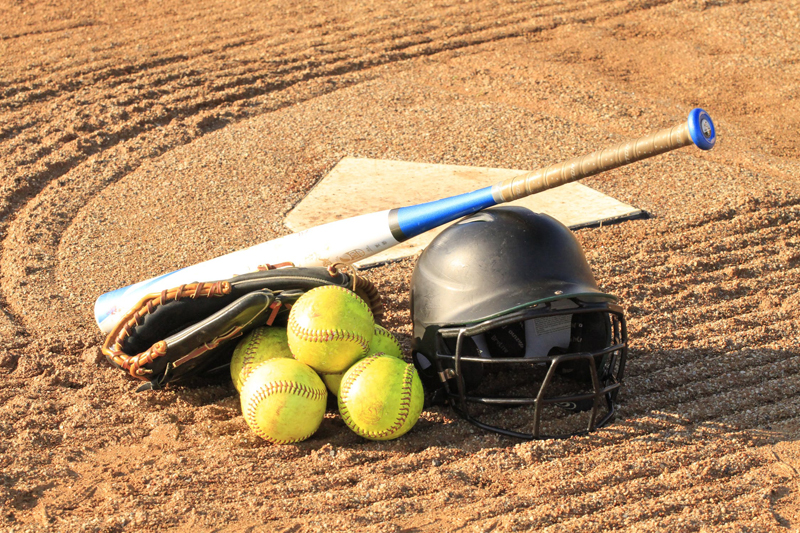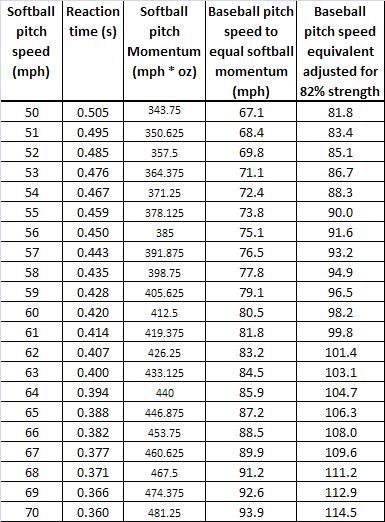Softball vs Baseball Pitch Momentum and Bunting

We have examined the reaction time and the equivalent baseball pitch speed and determined that because of the closer pitching distance in Fast Pitch Softball, a baseball has to be thrown about 45% faster to give the batter the same reaction time. There is another physical property of a pitched ball that can be used when comparing Fast Pitch softball pitching to Baseball pitching: momentum of the ball. We are going to examine the momentum of the ball and use that information to recommend a particular bunting technique in this article.
Like batter reaction time, momentum is an important physical property to consider when examining batting (and bunting and throwing) techniques of the female Fast Pitch softball player. Momentum can be thought of as the force or energy associated with a moving body. The formula for momentum is Mass times Velocity, so momentum increases if the speed of an object increases, or its weight (or both). Because a 12” softball weighs more than a baseball, the momentum of a softball will be higher than a baseball if both are traveling at the same speed. As we did for reaction time speeds, it is useful to show the baseball equivalent speed to generate the same momentum as a softball pitched at a certain speed.
We need one more bit of information to apply this information to bunting techniques (and later to batting techniques), and that is that the average 20 year old female Softball player has 82% of the muscle mass as a male Baseball player the same age. If both the male Baseball player and the female Softball player square around to bunt using the traditional one-hand-up-on-the-barrel-and-one-hand-at-the-knob-of-the-bat technique, then it is reasonable to assume that the Softball player will be able to resist the momentum of the pitched ball with 82% of the strength of the Baseball player.

The table to the right shows the corresponding pitched baseball speeds for a pitched softball, as well as reaction time for the batter. The total momentum for a Softball pitched at 60 mph is 412.5 mph * oz. Dividing the softball momentum by the weight of a baseball (5.125 oz) is how we derive that a baseball would have to be pitched at 80.5 mph to have the same momentum. In other words, generally speaking, bunting a 60 mph softball is the same as bunting an 80.5 mph baseball if both are being bunted by the same player (yes, a softball is bigger and actually smooshes a little easier than a baseball, but those facts are not relevant for this article).
However, because a female Softball player has less muscle mass than a Baseball player of the same age, she is only able to put a fraction of the force to the bat than a Baseball player does. The final column in the table is the equivalent baseball speed accounting for a woman’s smaller muscle mass. For her to bunt a 60 mph softball fastball, she would have to exert the same amount of proportional force to hold the bat steady against the ball as a Baseball player facing a 98.2 mph pitch!
This jibes with what my teams have experienced over the years. Using the traditional technique, my female players in 14U almost always foul off bunts, even after whole practices dedicated to bunting. Talk about FRUSTRATING!! I researched online to figure out what we were doing wrong when I stumbled upon one picture of a college player bunting with two hands up on the bat. Looking at that picture, decided to give this new technique a try since nothing else I was teaching was working. It was only after I saw it working consistently did I realize that my players just did not have the hand strength to hold the bat steady against a 12” softball pitched at speed.
This season is the first season that we have coached the 2-handed bunting technique since day 1, and it has worked wonderfully! I am still collecting statistics on the traditional versus the 2-handed approach, but seven games into the season, we have 7 sacrifice bunts and 5 bunts for hits in the score book. Our opponents have zero of either. If that is still not convincing, then factor in that seven of my 12 players are 10 year old girls in a 14U league and that the other two teams have three 10 year olds each. I think it is safe to say to say that my team is significantly smaller muscle-wise than either of our competitors, yet we bunt better. Additionally, because we are more successful bunting, our defense gets more practice against it and has defended the bunt well the few times our opponents have gotten one down fair.

I am convinced that the traditional bunting technique is inappropriate for the female Softball player. The 2-handed approach would probably benefit the average Baseball player, but in my opinion it is absolutely essential for the female Softball player to use it.
Like batter reaction time, momentum is an important physical property to consider when examining batting (and bunting and throwing) techniques of the female Fast Pitch softball player. Momentum can be thought of as the force or energy associated with a moving body. The formula for momentum is Mass times Velocity, so momentum increases if the speed of an object increases, or its weight (or both). Because a 12” softball weighs more than a baseball, the momentum of a softball will be higher than a baseball if both are traveling at the same speed. As we did for reaction time speeds, it is useful to show the baseball equivalent speed to generate the same momentum as a softball pitched at a certain speed.
We need one more bit of information to apply this information to bunting techniques (and later to batting techniques), and that is that the average 20 year old female Softball player has 82% of the muscle mass as a male Baseball player the same age. If both the male Baseball player and the female Softball player square around to bunt using the traditional one-hand-up-on-the-barrel-and-one-hand-at-the-knob-of-the-bat technique, then it is reasonable to assume that the Softball player will be able to resist the momentum of the pitched ball with 82% of the strength of the Baseball player.

The table to the right shows the corresponding pitched baseball speeds for a pitched softball, as well as reaction time for the batter. The total momentum for a Softball pitched at 60 mph is 412.5 mph * oz. Dividing the softball momentum by the weight of a baseball (5.125 oz) is how we derive that a baseball would have to be pitched at 80.5 mph to have the same momentum. In other words, generally speaking, bunting a 60 mph softball is the same as bunting an 80.5 mph baseball if both are being bunted by the same player (yes, a softball is bigger and actually smooshes a little easier than a baseball, but those facts are not relevant for this article).
However, because a female Softball player has less muscle mass than a Baseball player of the same age, she is only able to put a fraction of the force to the bat than a Baseball player does. The final column in the table is the equivalent baseball speed accounting for a woman’s smaller muscle mass. For her to bunt a 60 mph softball fastball, she would have to exert the same amount of proportional force to hold the bat steady against the ball as a Baseball player facing a 98.2 mph pitch!
This jibes with what my teams have experienced over the years. Using the traditional technique, my female players in 14U almost always foul off bunts, even after whole practices dedicated to bunting. Talk about FRUSTRATING!! I researched online to figure out what we were doing wrong when I stumbled upon one picture of a college player bunting with two hands up on the bat. Looking at that picture, decided to give this new technique a try since nothing else I was teaching was working. It was only after I saw it working consistently did I realize that my players just did not have the hand strength to hold the bat steady against a 12” softball pitched at speed.
This season is the first season that we have coached the 2-handed bunting technique since day 1, and it has worked wonderfully! I am still collecting statistics on the traditional versus the 2-handed approach, but seven games into the season, we have 7 sacrifice bunts and 5 bunts for hits in the score book. Our opponents have zero of either. If that is still not convincing, then factor in that seven of my 12 players are 10 year old girls in a 14U league and that the other two teams have three 10 year olds each. I think it is safe to say to say that my team is significantly smaller muscle-wise than either of our competitors, yet we bunt better. Additionally, because we are more successful bunting, our defense gets more practice against it and has defended the bunt well the few times our opponents have gotten one down fair.

I am convinced that the traditional bunting technique is inappropriate for the female Softball player. The 2-handed approach would probably benefit the average Baseball player, but in my opinion it is absolutely essential for the female Softball player to use it.
BellaOnline Softball Subject List: Coach´s Box, Health & Medical, History of Softball, International Softball, Organizations, Parents , Professional Softball, Reviews, Rules & Regulations, Scorekeeping, Stats & Analysis, Travel Ball |
This site needs an editor - click to learn more!
You Should Also Read:
Male vs. Female Muscle Mass over Time
Related Articles
Editor's Picks Articles
Top Ten Articles
Previous Features
Site Map
Content copyright © 2023 by Don McKay. All rights reserved.
This content was written by Don McKay. If you wish to use this content in any manner, you need written permission. Contact
BellaOnline Administration
for details.


